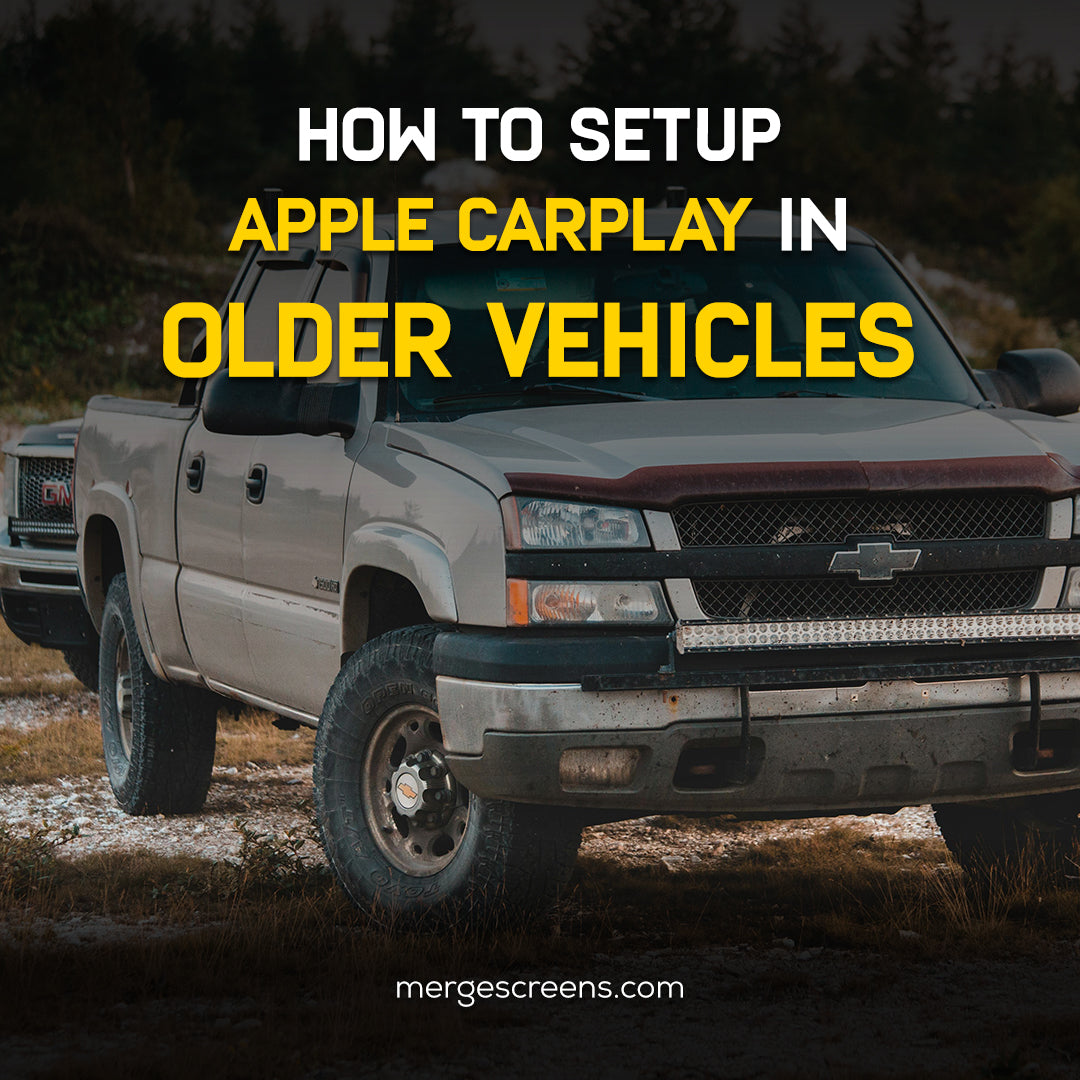How to Install Apple CarPlay in an Older Car

Let’s be real—just because your car isn’t brand new doesn’t mean you have to miss out on modern features like Apple CarPlay. Whether you’re driving a 2010 sedan or a trusty pickup that’s seen better days, upgrading to CarPlay brings a fresh tech experience that makes your ride feel brand new again.
In this guide, you’ll learn everything you need to know about installing Apple CarPlay in an older car. From choosing the right tools and parts to understanding installation costs and compatibility, we’ve got it all covered—without the jargon.
What is Apple CarPlay?
Apple CarPlay is Apple's in-car interface that brings your iPhone’s most essential functions—like navigation, messaging, music, and calls—directly onto your car’s screen. If your vehicle has the necessary hardware, you can use Siri voice commands, the touchscreen, or the buttons on the steering wheel to operate it.
Benefits of Adding CarPlay to Your Older Car
✓ Hands-free calling and texting
✓ Real-time navigation via Apple Maps, Google Maps, or Waze
✓ Spotify, Apple Music, and podcast integration
✓ Safer driving through voice control
✓ Adds resale value to your vehicle
Can You Install Apple CarPlay in an Older Vehicle?
Absolutely! As long as your car has space for a new head unit or you’re using a plug-and-play module, adding CarPlay is totally doable. Not your car's age but compatibility is what matters most.
Factory vs Aftermarket CarPlay
● Factory-installed CarPlay is standard in newer vehicles but rare in cars older than 2016.
● Aftermarket CarPlay involves replacing your existing stereo or adding a CarPlay module designed for your make and model.
Compatibility Check
Before buying anything, make sure both your car and iPhone can support the upgrade.
iPhone Requirements
● iPhone 5 or later
● iOS 7.1 or above (latest iOS versions recommended for wireless support)
Car Requirements
● Double DIN slot (for full stereo replacements)
● Existing screen or stereo system that supports external modules (for plug-and-play options)
Compatible Devices and Kits
Check out modules and screens that are purpose-built for specific vehicles. For example, if you're driving a Ford F-150 or Toyota Camry, custom kits are available to make installation seamless.
A full list of plug-and-play compatible modules is available on Merge Screens' Apple CarPlay & Android Auto Modules collection.
Tools and Materials You’ll Need
Before you pop the hood—or rather, the dash—here’s a list of basic tools to keep handy:
Essential Tools
● Flathead & Phillips screwdrivers
● Trim removal tool
● Wire strippers/crimpers
● Socket wrench set
● Electrical tape or heat shrink tubing
Optional but Helpful
● Multimeter (for checking power)
● Panel pry tools (to avoid scratches)
● Soldering kit (for permanent wiring)
Safety Tips
● Before working on any electrical parts, disconnect the battery from your car.
● Wear gloves and keep a clean workspace to avoid losing screws or damaging panels.
Types of CarPlay Upgrades
1. Plug-and-Play Modules
These are add-on modules that integrate with your existing screen. They’re vehicle-specific and often require minimal wiring.
2. Aftermarket Head Units
Replace your current stereo with a new one that includes CarPlay. You may upgrade your sound, Bluetooth, and screen with these devices, which fit into a Double DIN slot.
3. Wireless CarPlay Adapters
Already have a wired CarPlay setup? Wireless adapters plug into the USB port and let you connect without cables.
4. Tesla-Style Screens
Want to go full futuristic? Tesla-style vertical screens offer a premium look and integrate CarPlay seamlessly.
Step-by-Step Installation Guide
Let’s break this down into manageable steps:
Step 1: Choose the Right CarPlay Kit
Pick a kit that fits your car’s make, model, and year. Make sure it includes all wiring harnesses and adapters.
Step 2: Disconnect the Battery
To keep the airbag from breaking or short circuiting, you should always unhook the negative terminal.
Step 3: Remove the Factory Stereo
Use trim tools to carefully pop off the dash panel. Unscrew the stereo unit and unplug all connections.
Step 4: Connect the CarPlay Module
Follow the wiring diagram included in your kit. Most plug-and-play systems connect between the factory screen and original wiring.
Step 5: Route Wires and USB Ports
Tuck wires behind the dash and secure them with zip ties. Place the USB input somewhere easy to reach—like the glovebox or center console.
Step 6: Mount the Screen (if applicable)
If your kit comes with a new screen, secure it using the factory brackets or supplied mounts.
Step 7: Power Up and Test
Reconnect the battery. Turn on the car and check:
● Display shows up
● Audio works
● Touchscreen responds
● CarPlay connects with your iPhone
Step 8: Reassemble the Dash
Once everything is tested, reattach the trim and ensure there are no loose panels.
Professional Installation vs DIY
If you're tech-savvy and comfortable with tools, DIY is 100% possible and budget-friendly. But if your car has complex wiring (like premium factory audio), you might want a pro.
When to Call in the Pros
● No prior electrical experience
● Premium vehicles with CAN bus systems
● Custom screen integration needed
Cost Breakdown
Here’s what to expect:
|
Item |
Estimated Cost |
|
CarPlay Module or Head Unit |
$300 – $900 |
|
Installation Tools |
$30 – $100 |
|
Professional Labor (optional) |
$150 – $400 |
|
Add-ons (backup cam, etc.) |
$50 – $200 |
Budget-conscious? Consider starting with a wired CarPlay head unit, then upgrade to wireless later.
Where to Buy Reliable CarPlay Modules
Avoid sketchy marketplaces. Trustworthy brands should have warranties and customer service.
For high-quality, vehicle-specific kits, check out this guide on how to install CarPlay and explore trusted modules directly from MergeScreens' CarPlay Collection.
Common Installation Mistakes to Avoid
● Skipping compatibility checks: Not all kits work with all cars.
● Wrong wiring connections: Double-check everything before reconnecting the battery.
● Not updating firmware: Older modules might need a firmware upgrade to function properly.
Post-Installation Setup
Once CarPlay is installed:
1. You have the option to connect wirelessly or utilize a Lightning connector to attach your iPhone.
2. Enable CarPlay on your iPhone by turning on Siri.
3. You can change how apps are laid out on your car screen by going to iPhone Settings.
Troubleshooting Tips
No display? Check power cables and fuses.
Audio issues? Make sure the correct input source is selected.
Touch not responding? Try a firmware reset or consult your product manual.
Benefits of Apple CarPlay in an Older Car
● No need to buy a new vehicle to enjoy modern tech
● Safer hands-free communication and navigation
● Makes your car feel brand new
● Adds real resale value
Conclusion
Upgrading your older car with Apple CarPlay isn’t just a cool tech flex—it’s a smart move for convenience, safety, and resale value. Whether you go full DIY or get help from a pro, the transformation is totally worth it. With the right tools and a little patience, your daily drive will never be the same again.
FAQs
1. Is it possible to install Apple CarPlay in any vehicle?
If your car supports stereo replacement or plug-in modules, yes. Simply check to see if it is compatible with the kit that you have selected.
2. Does CarPlay work wirelessly in older cars?
Yes, but you'll need a wireless-capable module or a separate adapter.
3. Is Apple CarPlay worth the upgrade cost?
Absolutely. It enhances safety, functionality, and driving enjoyment without the cost of a new vehicle.
4. Will installing CarPlay void my warranty?
Not usually—but check with your dealership if your car is still under warranty.
5. How long does the installation process take?
A basic install takes 1–3 hours. More complex setups (like Tesla-style screens) may take longer.

